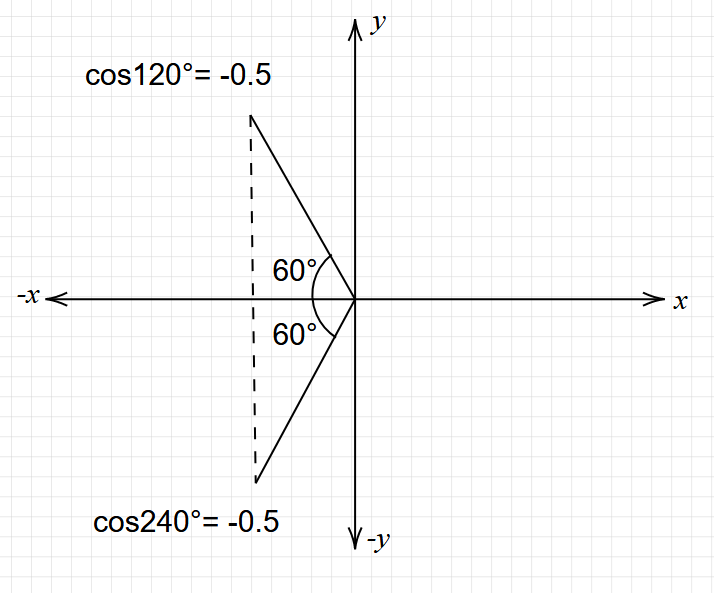Answer
381.6k+ views
Hint: The given trigonometric equation contains only one function which is $\cos x$. Hence we don’t have to simplify the equation any further.
The cosine function is a ratio of the adjacent side to the hypotenuse. If we know the cosine value of some important angles, it will be useful in finding the adjacent side and hypotenuse, given that any one of these sides is known.
Complete Step by Step Solution:
The given trigonometric equation is $2\cos x+1=0$. We can rearrange this equation as
$\Rightarrow 2\cos x=-1$
$\Rightarrow \cos x=\dfrac{-1}{2}$
Hence the variable x will be equal to
$\Rightarrow x={{\cos }^{-1}}\left( -\dfrac{1}{2} \right)$
We know that the cosine function will be negative in quadrants 2 and 3. This is because of the negative value of the adjacent side in these quadrants.

In the second quadrant, the cosine value will be equal to $-\dfrac{1}{2}$ at ${{120}^{{}^\circ }}$ or $\dfrac{2\pi }{3}$ , and in the second quadrant, the cosine value will be $-\dfrac{1}{2}$ at ${{240}^{{}^\circ }}$ or $\dfrac{4\pi }{3}$ as shown in the above figure.
And the cosine function is periodic with a period equal to $2\pi $.
Therefore the variable x will be given by the following equation.
$\Rightarrow x=\dfrac{2\pi }{3}+2\pi n,\dfrac{4\pi }{3}+2\pi n$ where n is an integer.
Note:
It is important to know the sign of the trigonometric ratios in all four quadrants. This will help us to sort out the position of the point in the coordinate system. In addition to that, we should consider the periodicity property of these trigonometric functions and we should include the period of the particular function in the final result.
The cosine function is a ratio of the adjacent side to the hypotenuse. If we know the cosine value of some important angles, it will be useful in finding the adjacent side and hypotenuse, given that any one of these sides is known.
Complete Step by Step Solution:
The given trigonometric equation is $2\cos x+1=0$. We can rearrange this equation as
$\Rightarrow 2\cos x=-1$
$\Rightarrow \cos x=\dfrac{-1}{2}$
Hence the variable x will be equal to
$\Rightarrow x={{\cos }^{-1}}\left( -\dfrac{1}{2} \right)$
We know that the cosine function will be negative in quadrants 2 and 3. This is because of the negative value of the adjacent side in these quadrants.

In the second quadrant, the cosine value will be equal to $-\dfrac{1}{2}$ at ${{120}^{{}^\circ }}$ or $\dfrac{2\pi }{3}$ , and in the second quadrant, the cosine value will be $-\dfrac{1}{2}$ at ${{240}^{{}^\circ }}$ or $\dfrac{4\pi }{3}$ as shown in the above figure.
And the cosine function is periodic with a period equal to $2\pi $.
Therefore the variable x will be given by the following equation.
$\Rightarrow x=\dfrac{2\pi }{3}+2\pi n,\dfrac{4\pi }{3}+2\pi n$ where n is an integer.
Note:
It is important to know the sign of the trigonometric ratios in all four quadrants. This will help us to sort out the position of the point in the coordinate system. In addition to that, we should consider the periodicity property of these trigonometric functions and we should include the period of the particular function in the final result.
Recently Updated Pages
Why Are Noble Gases NonReactive class 11 chemistry CBSE

Let X and Y be the sets of all positive divisors of class 11 maths CBSE

Let x and y be 2 real numbers which satisfy the equations class 11 maths CBSE

Let x 4log 2sqrt 9k 1 + 7 and y dfrac132log 2sqrt5 class 11 maths CBSE

Let x22ax+b20 and x22bx+a20 be two equations Then the class 11 maths CBSE

Let x1x2xn be in an AP of x1 + x4 + x9 + x11 + x20-class-11-maths-CBSE



